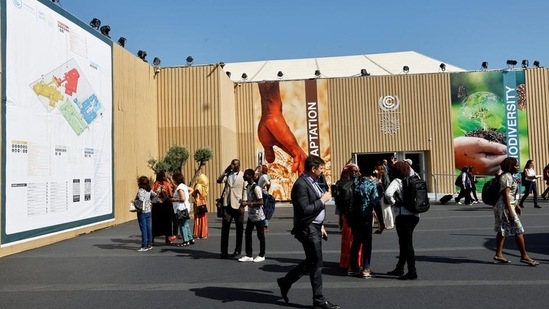Number Theory: India’s balancing act at the climate summit
Data from the World Resources Institute of Climate Watch (CAIT) dataset shows that India was the third-largest emitter of greenhouse gases (GHG) in absolute terms in 2019, after China and the United States.
At the Conference of the Parties (COP27), which is being held from November 6-18 in Egypt’s Sharm el-Sheikh, climate stakeholders are expected to build on COP26’s outcomes to address extreme climate-related emergencies. Given the backdrop of escalating geopolitical tension, an energy crisis, record greenhouse gas emissions and a global rise in extreme weather events, it is expected that COP27 will reaffirm international cooperation. Action to avert climate change is the need of the hour. The World Meteorological Organisation, in a report released on Friday, said that the global mean temperature in 2022 is currently estimated to be 1.15°C above the pre-industrial average (1850-1900).

Amid this urgency, a fast-growing, developing country like India has its own compulsions. It needs to grow at a fast pace to uplift millions, a by-product of which is more emissions. So, how does it balance its own objectives while warding off pressure from developed countries and servicing the imperatives of the planet?
India's relative emissions are much lower than others'
Data from the World Resources Institute of Climate Watch (CAIT) dataset shows that India was the third-largest emitter of greenhouse gases (GHG) in absolute terms in 2019, after China and the United States. India contributed 6.8% of the global average GHG emission in 209. Between 1990 and 2019, India's GHG emissions have increased at a compounded annual rate of about 4.2%.
Compared to total GHG emission, per capita GHG emission provided a more representative picture of a country's position and actual role in climate change. According to the United Nations Environment Programme's ‘Emission Gap Report 2022: The Narrowing Window’, India's per capita GHG emissions was 2.4 tonnes of CO2 equivalent (tCO2e) in 2020, which was much less than the world average of 6.3 tCO2e. It's even lower than developing peers like Brazil and Indonesia. United States' emissions were more than double the world average, at 14 tCO2e, followed by Russia (13 tCO2e), China (9.7 tCO2e), and the European Union (tCO2e).

It has managed to decouple growth from emissions
In recent years, India has decoupled economic growth from emissions. Data on India's emission inventory from 2005 to 2016 is taken from a working paper by the Centre for Science and Environment (CSE), which compiled this data from the biennial update reports (BUR) submitted by India to the UN Framework Convention on Climate Change (UNFCC) between 2015 and 2021. India's GHG emissions increased from 1,643 million tonnes CO2 in 2005 to 2,529 million tonnes CO2e in 2016.
In 2010, India made a voluntary declaration to reduce its ‘emission intensity’ - GHG emissions per unit of GDP - by 20-25% from its 2005 levels by 2020. In 2015, it enhanced this reduction target to 22-25% by 2030, as per the BUR-3 report of 2021. According to the CSE paper, India's emission intensity fell 24% between 2005 and 2016. In other words, India has decoupled economic growth from emissions, and is on its track to meet its emission intensity targets.

But it still has a high dependence on coal
The main contributor to India's GHG emissions in CO2, which is generated from burning fossil fuels, direct human-induced impacts on forestry and land use, and increasing aluminum and steel production. Data from CAIT shpws that the enegery sector alone accounted for 95.5% of the total CO2 emitted by all sectors in 2019.
The energy sector's heavy reliance on coal and other pollution fuels has contributed to high CO2 emissions, India's primary energy consumption increased 32% between 1990 and 2021, according to Our World in Data website, which compiled data from BP statistical review of World Energy, Coal is a big factor. India's primary energ consumption increased 10.1% in 2021 compared to 2022. Coal-vased energy consumption increased 15% on a year-to-tear basis in2021, while that of oil, gas, and renewable and waste fuel based less than 5%. The share of coal in total primary energy consumption has exceeded 50% for the last three decades, and a shift from coal to renewables in a major axis to lower CO2 emissions in India.

And reversing the loss of forest cover will be crucial
Achieving net zero emissions and becoming carbon neutral by 2070 was one of the five goals that India committed to in COP26. In simple terms, this means achieving an overall balance between GHG emissions produced and GHG emissions taken out of the atmosphere. The fulfillment of this goal requires increasing forest cover. In order to achieve this, the Declaration of Forests and land use was signed by 141 countries - though, not India - at COP26. Signatory nations committed to halt and reverse forest loss, land degradation by 2030.
India lost 376 thousand hectares (Kha) of humid primary forest cumulatively from 2001 to 2021, according to Global Forest Watch, a collaboration between the University of Maryland, Goggle, the US Geological Survey and NASA. This amounted to a loss of 18% of total primary tree over. On its part, even as it pursues a path of high growth, the shift to renewables and reversing the decline in its forest reserve holds the key for India in its objectives.
(Uma Gupta is a Hindustan Times-How India lives data journalist fellow)

Get Current Updates on India News, Lok Sabha election 2024 live, Election 2024 along with Latest News and Top Headlines from India and around the world.





